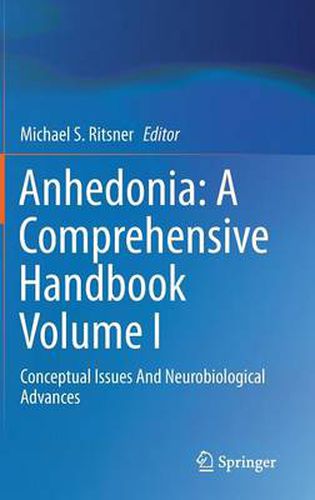Readings Newsletter
Become a Readings Member to make your shopping experience even easier.
Sign in or sign up for free!
You’re not far away from qualifying for FREE standard shipping within Australia
You’ve qualified for FREE standard shipping within Australia
The cart is loading…






This title is printed to order. This book may have been self-published. If so, we cannot guarantee the quality of the content. In the main most books will have gone through the editing process however some may not. We therefore suggest that you be aware of this before ordering this book. If in doubt check either the author or publisher’s details as we are unable to accept any returns unless they are faulty. Please contact us if you have any questions.
This is the first comprehensive two-volume collection on anhedonia, a disorder that played an important role in psychopathology theories at the beginning of the twentieth century. Anhedonia is a condition in which the capacity of pleasure is partially or completely lost, and it refers to both a personality trait, and a state symptom in various neuropsychiatric and physical disorders. It has a putative neural substrate, originating in the dopaminergic mesolimbic and mesocortical reward circuit. Over the past three decades cognitive psychology and behavioral neuroscience have expanded our understanding of anhedonia and other reward-related processes. The aim of this new two-volume collection on anhedonia is to highlight the contributions of eminent scientists in this field as well as to provide readers with comprehensive accounts of recent developments as perceived by the authors. This monograph is divided into five parts. Volume I contains parts one and two (Conceptual Issues and Neurobiological Advances) including 14 chapters that serve as an introduction and overview of conceptual issues. Volume II contains three parts (Anhedonia in Psychotic Disorders, Anhedonia in Mood and Personality Disorders, and Anhedonia in Neurological and Physical Disorders) including 15 chapters that provide an overview of the construct, measurement of anhedonia in schizophrenia spectrum disorders, hedonic capacity and related factors in schizophrenia and schizoaffective disorder, anhedonia as an indicator of genetic liability for schizophrenia, and as a trait marker for depression, the role of an anhedonia in trauma-related disorders, anorexia nervosa, stress-induced eating disorders, schizotypal traits and risk of suicide. This book will be of interest to a broad spectrum of readers including psychiatrists, psychologists, neurologists, neuroscientists, endocrinologists, pharmacologists, general practitioners, geriatricians, graduate students, and health care providers in the fields of mental health.
$9.00 standard shipping within Australia
FREE standard shipping within Australia for orders over $100.00
Express & International shipping calculated at checkout
This title is printed to order. This book may have been self-published. If so, we cannot guarantee the quality of the content. In the main most books will have gone through the editing process however some may not. We therefore suggest that you be aware of this before ordering this book. If in doubt check either the author or publisher’s details as we are unable to accept any returns unless they are faulty. Please contact us if you have any questions.
This is the first comprehensive two-volume collection on anhedonia, a disorder that played an important role in psychopathology theories at the beginning of the twentieth century. Anhedonia is a condition in which the capacity of pleasure is partially or completely lost, and it refers to both a personality trait, and a state symptom in various neuropsychiatric and physical disorders. It has a putative neural substrate, originating in the dopaminergic mesolimbic and mesocortical reward circuit. Over the past three decades cognitive psychology and behavioral neuroscience have expanded our understanding of anhedonia and other reward-related processes. The aim of this new two-volume collection on anhedonia is to highlight the contributions of eminent scientists in this field as well as to provide readers with comprehensive accounts of recent developments as perceived by the authors. This monograph is divided into five parts. Volume I contains parts one and two (Conceptual Issues and Neurobiological Advances) including 14 chapters that serve as an introduction and overview of conceptual issues. Volume II contains three parts (Anhedonia in Psychotic Disorders, Anhedonia in Mood and Personality Disorders, and Anhedonia in Neurological and Physical Disorders) including 15 chapters that provide an overview of the construct, measurement of anhedonia in schizophrenia spectrum disorders, hedonic capacity and related factors in schizophrenia and schizoaffective disorder, anhedonia as an indicator of genetic liability for schizophrenia, and as a trait marker for depression, the role of an anhedonia in trauma-related disorders, anorexia nervosa, stress-induced eating disorders, schizotypal traits and risk of suicide. This book will be of interest to a broad spectrum of readers including psychiatrists, psychologists, neurologists, neuroscientists, endocrinologists, pharmacologists, general practitioners, geriatricians, graduate students, and health care providers in the fields of mental health.